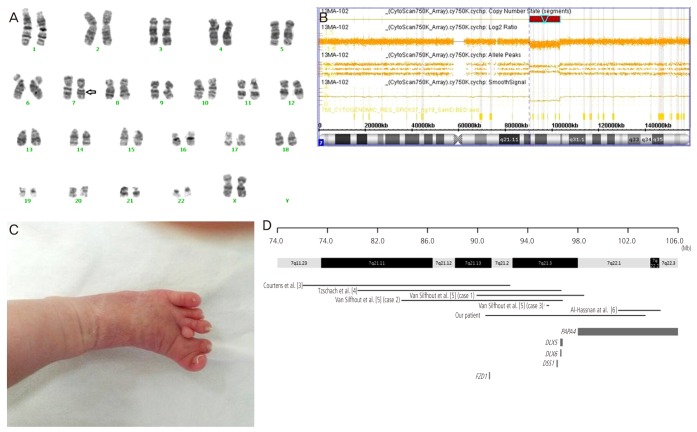Obstet Gynecol Sci.
2014 Jul;57(4):318-324. 10.5468/ogs.2014.57.4.318.
Prenatal diagnosis of a 7q21.13q22.1 deletion detected using high-resolution microarray
- Affiliations
-
- 1Department of Laboratory Medicine, Keimyung University School of Medicine, Deagu, Korea.
- 2Department of Obstetrics and Gynecology, Keimyung University School of Medicine, Deagu, Korea. gonmd@dsmc.or.kr
- 3Department of Pediatrics, Keimyung University School of Medicine, Deagu, Korea.
- KMID: 1841545
- DOI: http://doi.org/10.5468/ogs.2014.57.4.318
Abstract
- We report a case of de novo 7q interstitial deletion detected by conventional karyotyping and by microarray of amniotic fluid sampled during the prenatal period. A 32-year-old pregnant woman was evaluated at our hospital following detection of increased nuchal translucency at 12 weeks and 5 days of gestation. Conventional karyotyping revealed 46,XX,del(7)(q21q22) in 20 interphase mitotic cells, and high-resolution microarray revealed 12.8 Mb (90,625,014-103,430,901) deletion in the region 7q21.13q22.1. Both parents had normal karyotypes. After birth, the neonate displayed several anomalies, including palatine cleft, upslanted and wide palpebral fissure, low-set ears, micrognathia, microcephaly, ventriculomegaly, subglottic tracheal stenosis, hearing loss, and hand/foot deformities, including brachydactyly, polydactyly, and cutaneous syndactyly. This case study helps explain the phenotype-genotype relationship in patients with 7q21.13q22.1 deletion.
Keyword
MeSH Terms
Figure
Reference
-
1. Verma RS, Conte RA, Sayegh SE, Kanjilal D. The interstitial deletion of bands q33-35 of long arm of chromosome 7: a review with a new case report. Clin Genet. 1992; 41:82–86. PMID: 1544217.
Article2. Zackowski JL, Raffel LJ, Blank CA, Schwartz S. Proximal interstitial deletion of 7q: a case report and review of the literature. Am J Med Genet. 1990; 36:328–332. PMID: 2194394.
Article3. Courtens W, Vermeulen S, Wuyts W, Messiaen L, Wauters J, Nuytinck L, et al. An interstitial deletion of chromosome 7 at band q21: a case report and review. Am J Med Genet A. 2005; 134A:12–23. PMID: 15732063.
Article4. Tzschach A, Menzel C, Erdogan F, Schubert M, Hoeltzenbein M, Barbi G, et al. Characterization of a 16 Mb interstitial chromosome 7q21 deletion by tiling path array CGH. Am J Med Genet A. 2007; 143:333–337. PMID: 17230488.
Article5. Van Silfhout AT, van den Akker PC, Dijkhuizen T, Verheij JB, Olderode-Berends MJ, Kok K, et al. Split hand/foot malformation due to chromosome 7q aberrations(SHFM1): additional support for functional haploinsufficiency as the causative mechanism. Eur J Hum Genet. 2009; 17:1432–1438. PMID: 19401716.
Article6. Al-Hassnan ZN, Al-Bakheet A, Abu-Dheim N, Al-Younes B, Colak D, Kaya N. A novel interstitial microdeletion of 7q22.1-7q22.3 detected by array comparative genomic hybridization. Am J Med Genet A. 2011; 155A:3128–3131. PMID: 22002944.
Article7. Khan S, Basit S, Zimri FK, Ali N, Ali G, Ansar M, et al. A novel homozygous missense mutation in WNT10B in familial split-hand/foot malformation. Clin Genet. 2012; 82:48–55. PMID: 21554266.
Article8. Scherer SW, Poorkaj P, Allen T, Kim J, Geshuri D, Nunes M, et al. Fine mapping of the autosomal dominant split hand/split foot locus on chromosome 7, band q21.3-q22.1. Am J Hum Genet. 1994; 55:12–20. PMID: 8023840.9. Lo Iacono N, Mantero S, Chiarelli A, Garcia E, Mills AA, Morasso MI, et al. Regulation of Dlx5 and Dlx6 gene expression by p63 is involved in EEC and SHFM congenital limb defects. Development. 2008; 135:1377–1388. PMID: 18326838.
Article10. Bernardini L, Palka C, Ceccarini C, Capalbo A, Bottillo I, Mingarelli R, et al. Complex rearrangement of chromosomes 7q21.13-q22.1 confirms the ectrodactyly-deafness locus and suggests new candidate genes. Am J Med Genet A. 2008; 146A:238–244. PMID: 18080328.
Article11. Galjaard RJ, Smits AP, Tuerlings JH, Bais AG, Bertoli Avella AM, Breedveld G, et al. A new locus for postaxial polydactyly type A/B on chromosome 7q21-q34. Eur J Hum Genet. 2003; 11:409–415. PMID: 12734547.
Article12. Wieland I, Muschke P, Jakubiczka S, Volleth M, Freigang B, Wieacker PF. Refinement of the deletion in 7q21.3 associated with split hand/foot malformation type 1 and Mondini dysplasia. J Med Genet. 2004; 41:e54. PMID: 15121782.
Article13. Shamseldin HE, Faden MA, Alashram W, Alkuraya FS. Identification of a novel DLX5 mutation in a family with autosomal recessive split hand and foot malformation. J Med Genet. 2012; 49:16–20. PMID: 22121204.
- Full Text Links
- Actions
-
Cited
- CITED
-
- Close
- Share
- Similar articles
-
- Prenatal chromosomal microarray analysis of fetus with increased nuchal translucency
- Clinical application of prenatal chromosomal microarray
- Prenatal diagnosis of 4p deletion syndrome: A case series report
- Prenatal detection of Xq deletion by abnormal noninvasive prenatal screening, subsequently diagnosed by amniocentesis: A case report
- Prenatal diagnosis of 5p deletion syndrome: A case series report


